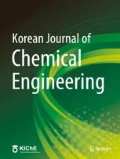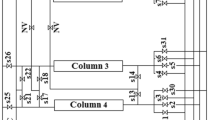Abstract
An experimental study was performed for the recovery of CO2 from flue gas of the electric power plant by pressure swing adsorption process. Activated carbon was used as an adsorbent. The equilibrium adsorption isotherms of pure component and breakthrough curves of their mixture (CO2 : N2 : O2=17 : 79 : 4 vol%) were measured. Pressure equalization step and product purge step were added to basic 4-step PSA for the recovery of strong adsorbates. Through investigation of the effects of each step and total feed rate, highly concentrated CO2 could be obtained by increasing the adsorption time, product purge time, and evacuation time simultaneously with full pressure-equalization. Based on the basic results, the 3-bed, 8-step PSA cycle with the pressure equalization and product purge step was organized. Maximum product purity of CO2 was 99.8% and recovery was 34%.
Similar content being viewed by others
References
Baksh, M. S., Kapoor, A. and Yang, R. T.,“A New Composite Sorbent for Methane-Nitrogen Separation by Pressure Swing Adsorption,”Sep. Sci. Technol.,25(7), 845 (1990).
Berlier, K. and Frere, M.,“Adsorption of CO2 on Activated Carbon: Simultaneous Determination of Integral Heat and Isotherm of Adsorption,”J. Chem. Eng. Data,41, 1144 (1996).
Chue, K. T., Kim, J. N., Yoo, Y. J. and Cho, S. H.,“Comparison of Activated Carbon and Zeolite 13X for CO2 Recovery from Flue Gas by Pressure Swing Adsorption,”Ind. Eng. Chem. Res.,34(2), 591 (1995).
Chung, Y., Na, B. K. and Song, H. K.,“Short-cut Evaluation of Pressure Swing Adsorption System,”Computers Chem. Engng,22, S637 (1998).
Doong, S. J. and Yang, R. T.,“Bulk Separation of Multicomponent Gas Mixtures by Pressure Swing Adsorption: Pore/Surface Diffusion and Equlibrium Models,”AIChE J.,32(3), 397 (1986).
Han, N. W.,“Correlation of Adsorption Equilibria of CO2 on Activated Carbon,”Korean J. Chem. Eng.,2, 63 (1985).
Jang, D. G., Shin, H. S., Kim, J. N., Cho, S. H. and Suh, S. S.,“An Analysis on Multibed PSA Process for Hydrogen Purification,”HWA-HAKKONGHAK,37, 882 (1999).
Kikkinides, E. S., Yang, R. T. and Cho, S. H.,“Concentration and Recovery of CO2 from Flue Gas by Pressure Swing Adsorption,”Ind. Eng. Chem. Res.,32(11), 2714 (1993).
Kim, J. N., Kim, K. I., Yoo, Y. J. and Cho, S. H.,“Separation and Recovery of CO2 using PSA Process,”Chem. Ind. and Tech.,10(5), 16 (1992).
Kim, Y. M. and Suh, S. S.,“A New Mass Transfer Model for Cyclic Adsorption and Desorption,”Korean J. Chem. Eng.,16, 401 (1999),
Kim, W. G., Yang, J., Han, S., Cho, C., Lee, C. H. and Lee, H.,“Experimental and Theoretical Study on H2/CO2 Separation by a Five-Step One-Column PSA Process,”Korean J. Chem. Eng.,12, 503 (1995).
Kim, Y., Yeo, Y.-K., Lee, H., Song, H. K., Chung, Y. and Na, B.-K.,“Simulation of PSA Process for CO2 Recovery from Flue Gas,”HWAHAK KONGHAK,36, 562(1998).
Lee, H., Choi, J. H., Yeo, Y. K., Song, H. K. and Na, B. K.,“Effect of Evacuation and Rinse Conditions on Performance in PSA Process for CO2 Recovery,”HWAHAK KONGHAK,38, 809 (2000).
Ruthven, D. M., Farooq, S. and Knaebel, K. S.,“Pressure Swing Adsorption,” VCH, New York (1994).
Sircar, S.,“Separation of Methane and Carbon Dioxide Gas Mixtures by Pressure Swing Adsorption,”Sep. Sci. Technol.,23, 333 (1988).
Sircar, S. and Golden, T. C.,“Isothermal and Isobaric Desorption of Carbon Dioxide by Purge,”Ind. Eng. Chem. Res.,34, 2881 (1995).
Sorial, G. A., Granville, W. H. and Daly, W. O.,“Adsorption Equlibrium for Oxygen and Nitrogen Gas Mixtures on 5A Molecular Sieves,”Chem. Eng. Sci.,38(9), 1517 (1983).
Shin, H. S. and Suh, S. S.,“Performance Analysis of a Multi-Bed PSA Process to Simulate a Countercurrent Flow of Adsorbent,”HWA-HAKKONGHAK,36, 930 (1998).
Suh, S. S., Moon, K. H., Kim, Y. M., Na, B. K. and Song, H. K.,“Comparison of Local Equilibrium Model and Mass Transfer Model for Prediction of PSA Performance,” in Fundamentals of Adsorption, M. D. LeVan (ed.), Kluwer Academic Publishers, Boston, MA, 881 (1996).
Yang, J., Park, M. W., Chang, J. W., Ko, S. M. and Lee, C. H.,“Effects of Pressure Drop in a PSA Process,”Korean J. Chem. Eng.,15,211 (1998).
Yang, R. T.,“Gas Separation by Adsorption Processes,” Butterworth, Boston (1987).
Author information
Authors and Affiliations
Corresponding author
Rights and permissions
About this article
Cite this article
Na, BK., Koo, KK., Eum, HM. et al. CO2 recovery from flue gas by PSA process using activated carbon. Korean J. Chem. Eng. 18, 220–227 (2001). https://doi.org/10.1007/BF02698463
Received:
Accepted:
Issue Date:
DOI: https://doi.org/10.1007/BF02698463




